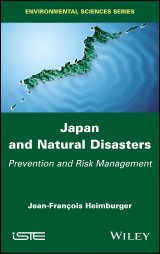Details
Japan and Natural Disasters
Prevention and Risk Management1. Aufl.
|
139,99 € |
|
| Verlag: | Wiley |
| Format: | EPUB |
| Veröffentl.: | 08.10.2018 |
| ISBN/EAN: | 9781119549796 |
| Sprache: | englisch |
| Anzahl Seiten: | 228 |
DRM-geschütztes eBook, Sie benötigen z.B. Adobe Digital Editions und eine Adobe ID zum Lesen.
Beschreibungen
<p>Japan is one of those countries most often affected by powerful natural hazards: earthquakes, tsunamis, volcanic eruptions, typhoons, heavy rains, heavy snowfall, tornadoes, etc. The Archipelago is considered a very advanced country in terms of forecasting, prevention and management of natural disasters. A detailed analysis of the reality of recent years is however necessary. In the run-up to the 2020 Olympic Games in Tokyo, among others, a publication on the subject will inform a large number of people wanting to know more about the risks of natural disasters in Japan.</p>
<p>Foreword xi</p> <p>Acknowledgments xiii</p> <p>Introduction xv</p> <p><b>Part 1. Hazards, Risks and Disasters 1</b></p> <p><b>Chapter 1. From Hazard to Disaster 3</b></p> <p>1.1. Hazard, vulnerability and risk 3</p> <p>1.2. Disaster 4</p> <p><b>Chapter 2. Earth and Fire 7</b></p> <p>2.1. Earthquakes 7</p> <p>2.1.1. Japan, principal seismic country 8</p> <p>2.1.2. The effects of earthquakes 9</p> <p>2.2. Volcanoes 13</p> <p>2.2.1. Japan, principal volcanic country 14</p> <p>2.2.2. Volcanic risks 16</p> <p>2.2.3. The benefits of volcanoes 17</p> <p><b>Chapter 3. Air and Water 21</b></p> <p>3.1. Strong winds 21</p> <p>3.1.1. Typhoons, spring winds and tornados 22</p> <p>3.1.2. Risks related to wind 24</p> <p>3.1.3. The benefits of wind 24</p> <p>3.2. Rainfall and snowfall 25</p> <p>3.2.1. Intense rains and flood risk 25</p> <p>3.2.2. Snow 31</p> <p>3.3. Heat waves 33</p> <p>3.3.1. The heat island phenomenon 33</p> <p>3.3.2. Damage related to heat 34</p> <p><b>Part 2. Risk Management 37</b></p> <p><b>Chapter 4. Disaster Prevention 39</b></p> <p>4.1. Concepts related to disaster prevention 39</p> <p>4.2. Laws, plans and budgets 40</p> <p>4.3. Business continuity plans 43</p> <p><b>Chapter 5. Risk Mitigation 45</b></p> <p>5.1. Hazard-proof buildings and residences 45</p> <p>5.1.1. In modern Japan 45</p> <p>5.1.2. The present day 46</p> <p>5.2. Securing critical infrastructure 51</p> <p>5.2.1. A predominantly overhead electrical grid 52</p> <p>5.2.2. The gas distribution network 53</p> <p>5.2.3. A water distribution system that is difficult to replace 54</p> <p>5.2.4. Securing shinkansen high-speed lines 54</p> <p>5.3. The battle against fires 56</p> <p>5.3.1. A variable risk 56</p> <p>5.3.2. Tokyo: a giant tinderbox 58</p> <p>5.3.3. Taking into account the risk of factory fires 59</p> <p>5.4. The fight against flooding 59</p> <p>5.4.1. The fight against coastal flooding 59</p> <p>5.4.2. The fight against flood rains 64</p> <p>5.5. The fight against mass movements 66</p> <p>5.6. The fight against heat islands 67</p> <p>5.7. The safety of nuclear power plants 69</p> <p>5.7.1. Establishing new regulations 70</p> <p>5.7.2. Confronting volcanic eruptions 71</p> <p>5.7.3. Facing earthquake shocks and tsunamis 72</p> <p>5.7.4. Facing heavy rains 73</p> <p><b>Chapter 6. Disaster Preparedness 75</b></p> <p>6.1. Prevention maps and signage 76</p> <p>6.2. Protection measures and storage 80</p> <p>6.3. Training, exercises and commemorations 82</p> <p>6.3.1. School education on disaster prevention 82</p> <p>6.3.2. Education on disaster prevention for everyone 84</p> <p>6.3.3. Commemorations 87</p> <p>6.4. Risk awareness 88</p> <p>6.4.1. Among Japanese people 88</p> <p>6.4.2. Among foreigners 89</p> <p><b>Chapter 7. Prediction, Monitoring, Warning and Preventive Evacuation 91</b></p> <p>7.1. Long-term forecasting 91</p> <p>7.1.1. Forecasting earthquakes: an impossible dream? 91</p> <p>7.1.2. Eruptions: limited forecasting 93</p> <p>7.1.3. The long-term forecasting of meteorological phenomena 95</p> <p>7.2. Monitoring and short-term forecasting 96</p> <p>7.2.1. Meteorological monitoring and forecasting 97</p> <p>7.2.2. Monitoring waterways 98</p> <p>7.2.3. Monitoring mass movements 99</p> <p>7.2.4. The detection of seismic and tsunami waves 99</p> <p>7.2.5. Monitoring volcanic activity 100</p> <p>7.3. Warnings 102</p> <p>7.3.1. Earthquake warnings 102</p> <p>7.3.2. Tsunami warnings 104</p> <p>7.3.3. Warning in case of volcanic eruption 105</p> <p>7.3.4. Warnings in case of meteorological phenomena 107</p> <p>7.3.5. The new emergency warning system 109</p> <p>7.4. Preventive evacuation 111</p> <p>7.4.1. Before a violent earthquake 111</p> <p>7.4.2. Hesitation to evacuate after a violent earthquake in anticipation of tsunami or a fire 112</p> <p>7.4.3. In case of risk of intense rainfall: to evacuate or not to evacuate? 114</p> <p>7.4.4. Evacuating in the face of volcanic dangers 116</p> <p>7.4.5. People requiring special attention 119</p> <p>7.4.6. Relocation 120</p> <p><b>Part 3. Disaster Management 121</b></p> <p><b>Chapter 8. Crisis Management 123</b></p> <p>8.1. Mobilization of the authorities . . . . . 124</p> <p>8.1.1. Crisis management centers 124</p> <p>8.1.2. Mobilization of rescue teams 125</p> <p>8.1.3. Management of dead bodies 133</p> <p>8.2. Mobilization of residents 135</p> <p>8.2.1. Neighborhood communities and local associations 135</p> <p>8.2.2. The actions of volunteers 136</p> <p>8.3. The circulation of information 137</p> <p>8.3.1. Social networks 137</p> <p>8.3.2. Rumors 138</p> <p>8.3.3. Media coverage 140</p> <p>8.4. Evacuation 143</p> <p>8.4.1. The initial period in the evacuation centers 144</p> <p>8.4.2. Mental health 145</p> <p>8.4.3. Temporary care of non-residents 146</p> <p><b>Chapter 9. Restoration and Reconstruction 149</b></p> <p>9.1. Rebuilding the lives of disaster victims 149</p> <p>9.1.1. Life in evacuation centers 149</p> <p>9.1.2. Security in devastated areas 151</p> <p>9.1.3. Settlement in temporary housing 152</p> <p>9.1.4. Prolonged stays in temporary housing 154</p> <p>9.1.5. Financial tools for reconstructing the lives of disaster victims 155</p> <p>9.1.6. Moral and psychological support 158</p> <p>9.2. Restoration and reconstruction of infrastructure 160</p> <p>9.2.1. Responsibilities and financing 161</p> <p>9.2.2. Waste management 162</p> <p>9.2.3. Restoration of vital infrastructure 164</p> <p>9.2.4. Restoration of public institutions: the example of schools 168</p> <p>9.2.5. Restoration of businesses 168</p> <p>9.2.6. Managing reconstruction costs 169</p> <p>9.3. Demographic and economic development 170</p> <p>9.4. Political consequences 172</p> <p>9.5. Memory 173</p> <p>Conclusion 177</p> <p>Appendix 179</p> <p>References 183</p> <p>Index 203</p>
<p><b>Jean-François HEIMBURGER</b>, independent researcher specializing in natural, biological, technological and social risks in Japan, and member of The Volcanological Society of Japan.</p>
Diese Produkte könnten Sie auch interessieren:

Water Quality Hazards and Dispersion of Pollutants

von: Wlodzimierz Czernuszenko, Pawel Rowinski

149,79 €
















